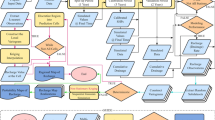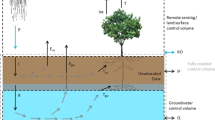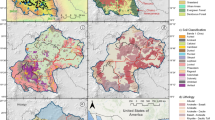Abstract
Parameterisation of unsaturated flow models for estimating spatial-scale groundwater recharge is usually reliant on expert knowledge or best-estimated parameters rather than robust uncertainty analysis. This study chose the Campaspe catchment in southeastern Australia as a field example and examined the uncertainty of spatial groundwater recharge by performing uncertainty analysis. The study area was first divided into 13 zones according to different vegetation types, soil groups and precipitation. Individual models were then established for these zones using the biophysically based modelling code WAVES (Water Atmosphere Vegetation Energy and Solutes), which is capable of simulating unsaturated flow. The Monte Carlo method, together with the Latin-Hypercube sampling technique, was employed to perform uncertainty analysis by comparing modelled monthly evapotranspiration (ET) to MODIS ET. The results show that the common one-estimate-per-site approach can still identify the spatial pattern of groundwater recharge in the study area due to the presence of a precipitation pattern. In comparison, the uncertainty analysis not only identifies the spatial pattern, but also provides confidence levels in groundwater recharge that are critical for water resources management. The results also show that recharge absolute uncertainty is directly proportional to the amount of water input, but relative uncertainty in recharge is not. This study indicates that spatial recharge estimation without model calibration or knowledge of model uncertainty could be highly uncertain. MODIS ET can be used to reduce recharge uncertainty, but it is unlikely to lower the recharge uncertainty by a large extent because of the MODIS ET estimation error.
Résumé
Le paramétrage des modèles d’écoulements non saturés pour estimer la recharge des eaux souterraines à l’échelle spatiale dépend habituellement de connaissances d’experts ou de paramètres les mieux estimés plutôt que d’une analyse d’incertitude robuste. Cette étude a choisi le bassin versant de Campaspe dans le sud-est de l’Australie comme un exemple de terrain et a examiné l’incertitude de la recharge spatialisée des eaux souterraines en réalisant une analyse d’incertitude. La zone d’étude a été tout d’abord divisée en 13 zones en considérant les différents types de végétation, de groupes de sol et des précipitations. Des modèles individuels ont été ensuite établis pour ces zones en utilisant le code de modélisation WAVES (Water Athmosphere Vegetation Energy and Solutes) basé sur la biophysique, qui est. capable de simuler les écoulements non saturés. La méthode Monte Carlo, associé à la technique d’échantillonnage Latin-Hypercube, a été employée pour réaliser l’analyse d’incertitude en comparant l’évapotranspiration (ET) modélisée au pas de temps mensuel à l’ET MODIS. Les résultats montrent que l’approche commune à une estimation par site peut encore identifier la configuration spatiale de la recharge des eaux souterraines dans la zone d’étude en raison de la présence d’un modèle de précipitation. En comparaison, l’analyse d’incertitude n’identifie pas seulement une configuration spatiale, mais fournit des niveaux de confidence dans la recharge des eaux souterraines qui sont importantes pour la gestion des ressources en eau. Les résultats indiquent également que l’incertitude absolue concernant la recharge est. directement proportionnelle à la quantité d’eau qui s’infiltre, mais l’incertitude relative dans la recharge ne l’est. pas. Cette étude indique que l’estimation de la recharge à l’échelle spatiale sans calibration du modèle ou sans connaissance de l’incertitude du modèle pourrait être fortement incertaine. MODIS ET peut être utilisé pour réduire l’incertitude sur la recharge, mais il est. peu probable qu’il puisse abaisser l’incertitude sur la recharge en grande partie en raison de l’erreur d’estimation de MODIS ET.
Resumen
La parametrización de los modelos de flujo no saturado para estimar la recarga del agua subterránea a escala espacial generalmente depende del conocimiento experto o de los parámetros mejor estimados en lugar de un sólido análisis de incertidumbre. Este estudio eligió la cuenca de drenaje de Campaspe en el sureste de Australia como un ejemplo de campo y examinó la incertidumbre de la recarga espacial del agua subterránea mediante la realización de un análisis de incertidumbre. El área de estudio se dividió en principio en 13 zonas según los diferentes tipos de vegetación, los grupos de suelos y la precipitación. Luego se establecieron modelos individuales para estas zonas utilizando el código de modelado WAVES (Water Atmosphere Vegetation Energy and Solutes), basado en la biofísica, que es capaz de simular el flujo no saturado. El método de Monte Carlo, junto con la técnica de muestreo Latin-Hypercube, se empleó para realizar el análisis de incertidumbre mediante la comparación de la evapotranspiración (ET) mensual modelada con MODIS ET. Los resultados muestran que el enfoque común de una estimación por sitio puede identificar el patrón espacial de recarga del agua subterránea en el área de estudio debido a la presencia de un patrón de precipitación. En comparación, el análisis de incertidumbre no solo identifica el patrón espacial, sino que proporciona niveles de confianza para la recarga del agua subterránea que son críticos para la gestión de los recursos hídricos. Los resultados también muestran que la incertidumbre absoluta de la recarga es directamente proporcional a la cantidad de ingreso de agua, pero no la incertidumbre relativa en la recarga. Este estudio indica que la estimación de la recarga espacial sin calibración del modelo o el conocimiento de la incertidumbre del modelo podría ser altamente incierto. MODIS ET se puede usar para reducir la incertidumbre de la recarga, pero es poco probable que reduzca la incertidumbre de la recarga en gran medida debido al error de estimación MODIS ET.
摘要
估算空间尺度地下水补给的非饱和水流模型的参数化通常依赖于专门知识或者最好的估算参数,而不是依赖于强大的不确定性分析。本研究选择澳大利亚东南部Campaspe流域作为一个野外实例,通过进行不确定性分析检查了空间地下水补给的不确定性。根据不同的植被类型、土壤组和降水情况,首先把研究区分为13个区。然后采用基于生物物理学上的模拟编码WAVES(水大气植被能量和溶质)为这些区建立了各自的模型,该模型能够模拟非饱和水流。通过比较模拟的每月蒸发蒸腾和MODIS ET,采用蒙特卡洛法以及拉丁超立方抽样技术进行不确定性分析。结果显示,由于存在着降水模式,普通的一地一估算方法仍然能确定研究区地下水补给的空间模式。相比之下,不确定性分析不仅能够确定空间模式,而且还能提供地下水补给中的置信级别,这对于水资源管理至关重要。结果还显示,补给绝对不确定性与水输入量成正比,但是补给的相对不确定性并不是如此。本研究表明,没有模型校正或模型不确定性知识的空间补给估算可能高度不确定。MODIS ET可用于减少补给不确定性,但是由于MODIS ET估算误差,很可能在很大程度上降低补给不确定性。
Resumo
Parametrização de modelos de fluxo de zona não saturada para estimativa da recarga de águas subterrâneas em escala espacial é normalmente dependente em conhecimento especializado ou parâmetros otimamente estimados ao invés de análise de incerteza. Esse estudo escolheu a bacia Campaspe na porção sudoeste da Austrália como exemplo de campo e examinou a incerteza da recarga de águas subterrâneas espacial através da análise de incerteza. A área de estudo foi primeiro dividida em 13 zonas de acordo com os tipos diferentes de vegetação, grupos de solos e precipitação. Modelos individuais foram então estabelecidos para essas zonas utilizando o código de modelagem baseado em biofísica WAVES (Águas Atmosfera Vegetação Energia e Solutos), queé capaz de simular o fluxo em zona não saturada. O método de Monte Carlo, em conjunto com a técnica de amostragem Latin-Hypercube foram empregados para fazer a análise de incerteza, comparando evapotranspiração (ET) mensalmente modelada e ET do MODIS. Os resultados demonstram que a abordagem comum de uma estimativa por local ainda pode identificar que o padrão espacial da recarga de águas subterrâneas na área estudada pela presença de um padrão de precipitação. Em comparação, a análise de incerteza não apenas identifica o padrão espacial, mas provém níveis de confiança na recarga de águas subterrâneas que são criticos para o gerenciamento dos recursos hídricos. Os resultados também demonstram que a incerteza absoluta da recarga está diretamente proporcional à quantidade de entrada de água, mas a incerteza relativa não o é. Esse estudo indica que estimar recarga espacial sem a calibragem do modelo ou conhecimento da incerteza do modelo poderia ser altamente incerto. ET do MODIS pode ser utilizada para reduzir a incerteza da recarga, mas é improvável que reduza a incerteza da recarga por uma grande extensão por causa do erro de estimativa da ET do MODIS.












Similar content being viewed by others
References
Anuraga TS, Ruiz L, Kumar MSM, Sekhar M, Leijnse A (2006) Estimating groundwater recharge using land use and soil data: a case study in South India. Agric Water Manag 84:65–76
Alcalá FJ, Custodio E (2014) Spatial average aquifer recharge through atmospheric chloride mass balance and its uncertainty in continental Spain. Hydrol Process 28:218–236. https://doi.org/10.1002/hyp.9556
Alcalá FJ, Custodio E (2015) Natural uncertainty of spatial average aquifer recharge through atmospheric chloride mass balance in continental Spain. J Hydrol 524:642–661
Australian Government (2010) Maps of average conditions. Bureau of Meteorology. http://www.bom.gov.au/climate/averages/maps.shtml. Accessed 3 July 2018
Australian Government (2016) Catchment scale land use of Australia. Department of Agriculture and Water. http://data.daff.gov.au/anrdl/metadata_files/pb_luausg9abll20160616_11a.xml. Accessed 3 July 2018
Batelaan O, De Smedt F (2001) WetSpass: a flexible, GIS based, distributed recharge methodology for regional groundwater modelling. IAHS, Wallingford, UK, pp 11–18
Blasone RS, Madsen H, Rosbjerg D (2008) Uncertainty assessment of integrated distributed hydrological models using GLUE with Markov chain Monte Carlo sampling. J Hydrol 353(1–2):18–32
Broadbridge P, White I (1998) Constant rate rainfall infiltration: a versatile nonlinear model—I. analytical solution. Water Resour Res 24:145–154
Carsel RF, Parrish RS (1988) Developing joint probability distributions of soil water retention characteristics. Water Resour Res 24(5):755–769
Chand R, Chandra S, Rao VA, Singh VS, Jain SC (2004) Estimation of natural recharge and its dependency on sub-surface geoelectric parameters. J Hydrol 299:67–83. https://doi.org/10.1016/j.jhydrol.2004.04.001
Cheng L, Zhang L, Wang Y, Yu Q, Eamus D, O’Grady A (2014) Impacts of elevated CO2, climate change and their interactions on water budgets in four different catchments in Australia. J Hydrol 519(Part B):1350–1361
Crosbie RS, McCallum JL, Walker GR, Chiew FHS (2010a) Modelling climate-change impacts on groundwater recharge in the Murray-Darling Basin, Australia. Hydrogeol J 18:1639–1656. https://doi.org/10.1007/s10040-010-0625-x
Crosbie RS, Jolly ID, Leaney FW, Petheram C (2010b) Can the dataset of field based recharge estimates in Australia be used to predict recharge in data-poor areas? Hydrol Earth Syst Sci 14(10):2023–2038. https://doi.org/10.5194/hess-14-2023-2010
Crosbie RS, Pickett T, Mpelasoka FS, Hodgson G, Charles SP, Barron OV (2013) An assessment of the climate change impacts on groundwater recharge at a continental scale using a probabilistic approach with an ensemble of GCMs. Clim Change 117:41–53. https://doi.org/10.1007/s10584-012-0558-6
Crosbie RS, Peeters LJM, Herron N, McVicar TR, Herr A (2017) Estimating groundwater recharge and its associated uncertainty: Use of regression kriging and the chloride mass balance method. J Hydrol. https://doi.org/10.1016/j.jhydrol.2017.08.003
CSIRO (2008) Water availability in the Campaspe: a report to the Australian Government from the CSIRO Murray-Darling Basin Sustainable Yields Project. CSIRO, Canberra, Australia, 120 pp
Cook PG, Jolly ID, Walker GR, Robinson NI (2003) From drainage to recharge to discharge: some timelags in subsurface hydrology. Dev Water Sci 50(C):319–326
de Vries JJ, Simmers I (2002) Groundwater recharge: an overview of processes and challenges. Hydrogeol J 10:5–17
Döll P, Fiedler K (2008) Global-scale modeling of groundwater recharge. Hydrol Earth Syst Sci 12:863–885. https://doi.org/10.5194/hess-12-863-2008
Dripps WR, Bradbury KR (2010) The spatial and temporal variability of groundwater recharge in a forested basin in northern Wisconsin. Hydrol Process 24:383–392
Glenn EP, Doody TM, Guerschman JP, Huete AR, King EA, McVicar TR, Van Dijk AIJM, Van Niel TG, Yebra M, Zhang Y (2011) Actual evapotranspiration estimation by ground and remote sensing methods: the Australian experience. Hydrol Process 25(26):4103–4116
Grayson R, Argent R, Nathan R, McMahon T, Mein R (1998) Hydrological recipes: estimation techniques in Australian Hydrology. CRC Catchment Hydrology, Monash University, Melbourne, Australia
Kalma J, McVicar T, McCabe M (2008) Estimating land surface evaporation: a review of methods using remotely sensed surface temperature data. Surv Geophys 29(4–5):421–469
Keese KE, Scanlon BR, Reedy RC (2005) Assessing controls on diffuse groundwater recharge using unsaturated flow modeling. Water Resour Res 41. https://doi.org/10.1029/2004WR003841
Kennett-Smith A, Cook PG, Walker GR (1994) Factors affecting groundwater recharge following clearing in the south western Murray Basin. J Hydrol 154(1):85–105
Kim JH, Jackson RB (2012) A global analysis of groundwater recharge for vegetation, climate, and soils. Vadose Zone J 11(1). https://doi.org/10.2136/vzj2011.0021RA.
Hartmann A, Gleeson T, Rosolem R, Pianosi F, Wada Y, Wagener T (2015) A large-scale simulation model to assess karstic groundwater recharge over Europe and the Mediterranean. Geosci Model Dev 8:1729–1746
Hu G, Jia L, Menenti M (2015) Comparison of MOD16 and LSA-SAF MSG evapotranspiration products over Europe for 2011. Remote Sens Environ 156:510–526
Isbell R (1996) The Australian soil classification. CSIRO, Canberra, Australia
Jeffrey SJ, Carter JO, Moodie KB, Beswick AR (2001) Using spatial interpolation to construct a comprehensive archive of Australian climate data. Environ Model Softw 16(4):309–330
Jyrkama MI, Sykes JF, Normani SD (2002) Recharge estimation for transient ground water modeling. Ground Water 40:638–648
Mathias SA, Sorensen JPR, Butler AP (2017) Soil moisture data as a constraint for groundwater recharge estimation. J Hydrol 552:258–266
McCallum JL, Crosbie RS, Walker GR, Dawes WR (2010) Impacts of climate change on groundwater in Australia: a sensitivity analysis of recharge. Hydrogeol J 18:1625–1638.
MODIS Global Evapotranspiration Project (2018) http://www.ntsg.umt.edu/project/modis/mod16.php. Accessed 3 July 2018
Nolan BT, Baehr AL, Kauffman LJ (2003) Spatial variability of groundwater recharge and its effect on shallow groundwater quality in southern New Jersey. Vadose Zone J 2:677
Scanlon BR, Keese KE, Flint AL, Flint LE, Gaye CB, Edmunds WM, Simmers I (2006) Global synthesis of groundwater recharge in semiarid and arid regions. Hydrol Process 20(15):3335–3370
Shamsudduha M, Taylor RG, Ahmed KM, Zahid A (2011) The impact of intensive groundwater abstraction on recharge to a shallow regional aquifer system: evidence from Bangladesh. Hydrogeol J 19:901–916
Tan XC, Wu JW, Cai SY, Yang JZ (2014) Characteristics of groundwater recharge on the North China Plain. Groundwater 52:798–807
Terrestrial Ecosystem Research Network (2018) Soil and landscape grid of Australia. http://www.clw.csiro.au/aclep/soilandlandscapegrid/index.html. Accessed 3 July 2018
Velpuri NM, Senay GB, Singh RK, Bohms S, Verdin JP (2013) A comprehensive evaluation of two MODIS evapotranspiration products over the conterminous United States: using point and gridded FLUXNET and water balance ET. Remote Sens Environ 139:35–49
Ward AS, Payn RA, Gooseff MN, McGlynn BL, Bencala KE, Kelleher CA, Wondzell SM, Wagener T (2013) Variations in surface water-ground water interactions along a headwater mountain stream: comparisons between transient storage and water balance analyses. Water Resour Res 49(6):3359–3374
Westerhoff R, White P, Rawlinson Z (2018) Incorporation of satellite data and uncertainty in a nationwide groundwater recharge model in New Zealand. Remote Sens 10(1):58. https://doi.org/10.3390/rs10010058
Westenbroek SM, Kelson VA, Dripps WR, Hunt RJ, Bradbury KR (2010) SWB: a modified Thornthwaite-Mather soil-water-balance code for estimating groundwater recharge. US Geol Surv Techniques Methods 6-A31, 60 pp
Williams NH, Misstear B, Daly D, Johnston P, Lee M, Cooney P, Hickey C (2011) A national groundwater recharge map for Ireland. Natl Hydrol Conf 2011
Wohling DL, Leaney FW, Crosbie RS (2012) Deep drainage estimates using multiple linear regression with percent clay content and rainfall. Hydrol Earth Syst Sci 16(2):563–572
Xie Y, Batlle-Aguilar J (2017) Limits of heat as a tracer to quantify transient lateral river–aquifer exchanges. Water Resour Res 53. https://doi.org/10.1002/2017WR021120
Xie Y, Cook PG, Shanafield M, Simmons CT, Zheng C (2016) Uncertainty of natural tracer methods for quantifying river–aquifer interaction in a large river. J Hydrol 535:135–147
Xie Y, Cook PG, Simmons CT, Partington D, Crosbie R, Batelaan O (2018) Uncertainty of groundwater recharge estimated from a water and energy balance model. J Hydrol 561:1081–1093
Zhang L, Hume IH, O’Connell MG, Mitchell DC, Milthorpe PL, Yee M, Dawes WR, Hatton TJ (1999) Estimating episodic recharge under different crop/pasture rotations in the Mallee region: part 1. experiments and model calibration. Agric Water Manag 42(2):219–235
Zhang L, Dawes WR (1998) WAVES: an integrated energy and water balance model. Technical report no. 31/98. CSIRO Land and Water, Canberra, Australia
Zhang YK, Schilling KE (2006) Effects of land cover on water table, soil moisture, evapotranspiration, and groundwater recharge: a field observation and analysis. J Hydrol 319:328–338
Acknowledgements
This study benefitted from discussions with Dr. John Hutson and Associate Professor Murk Bottema from Flinders University, and Professor Derek Eamus from the University of Technology Sydney.
Funding
The authors are grateful to the Murray-Darling Basin Authority for the financial support for this project.
Author information
Authors and Affiliations
Corresponding author
Rights and permissions
About this article
Cite this article
Xie, Y., Crosbie, R., Simmons, C.T. et al. Uncertainty assessment of spatial-scale groundwater recharge estimated from unsaturated flow modelling. Hydrogeol J 27, 379–393 (2019). https://doi.org/10.1007/s10040-018-1840-0
Received:
Accepted:
Published:
Issue Date:
DOI: https://doi.org/10.1007/s10040-018-1840-0




